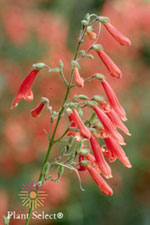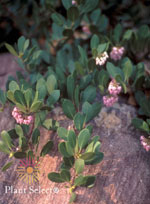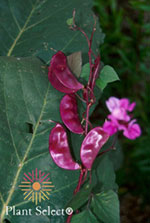The Plant Select® program of 2006 introduces and recommends the following plants for regional gardens. This year’s selections reflect the program’s standard for outstanding performance in gardens in the Rocky Mountain region and beyond.
Bridges’ Penstemon (Penstemon rostriflorus) is native to the southwestern states and attracts hummingbirds to the home garden. This penstemon with orange-red flowers is noted for flowering later in the season and for having a longer life span than many penstemon species. Sunny, dry areas are best, although it will adapt to light shade. Once established, Bridges’ Penstemon needs only occasional irrigation. This is a wonderful, attractive native plant for late summer color in your garden.
 Fernbush (Chamaebatiaria millefolium) is another wonderful native plant from the southwest that brings a unique beauty to a garden. Although deciduous, Fernbush gives the appearance of being an evergreen shrub in the winter due to the foliate buds. The leaves are deeply lobed and pleasantly aromatic when brushed. Long clusters of white flowers appear in June and continue into August. This is an extremely useful and low maintenance shrub for sunny, dry garden areas.
Fernbush (Chamaebatiaria millefolium) is another wonderful native plant from the southwest that brings a unique beauty to a garden. Although deciduous, Fernbush gives the appearance of being an evergreen shrub in the winter due to the foliate buds. The leaves are deeply lobed and pleasantly aromatic when brushed. Long clusters of white flowers appear in June and continue into August. This is an extremely useful and low maintenance shrub for sunny, dry garden areas.
 Giant Sacaton (Sporobolus wrightii) is a southwestern native grass that is substantial, large and drought tolerant. Many non-native ornamental grasses such as Maiden Grass are popular with gardeners, but not nearly as drought tolerant as Giant Sacaton. The tawny seed heads can easily reach to six feet providing an impressive and structural addition to the garden. It turns a lovely golden color in the winter as it continues to provide interest. An occasional deep watering in the driest months will suffice to keep Giant Sacaton growing well. It will thrive in average garden soil. Cut it to the ground in early spring to remove the previous year’s growth and enjoy the fresh display as it develops through the summer.
Giant Sacaton (Sporobolus wrightii) is a southwestern native grass that is substantial, large and drought tolerant. Many non-native ornamental grasses such as Maiden Grass are popular with gardeners, but not nearly as drought tolerant as Giant Sacaton. The tawny seed heads can easily reach to six feet providing an impressive and structural addition to the garden. It turns a lovely golden color in the winter as it continues to provide interest. An occasional deep watering in the driest months will suffice to keep Giant Sacaton growing well. It will thrive in average garden soil. Cut it to the ground in early spring to remove the previous year’s growth and enjoy the fresh display as it develops through the summer.
 KINTZLEY’S GHOST® Honeysuckle (Lonicera reticulata) is an improved selection of the species brought to the Plant Select® program from plantsman Scott Skogerboe of Fort Collins Wholesale Nursery in Fort Collins, Colorado. Scott observed the vine at a home in Fort Collins and discovered that it was an heirloom vine brought to Colorado by the family of an early horticulturist at Iowa State University, William Kintzley. Although the showy yellow flowers lack the fragrance typically associated with honeysuckle, they cover the vine in June and the distinctive appearance of eucalyptus-like bracts more than makes up for the flowers not being heavily scented. The vine is easy to grow and is undemanding, requiring only average garden loam and moderate irrigation. The unusual and distinctive appearance makes this a “must have” for gardeners wanting something new and different.
KINTZLEY’S GHOST® Honeysuckle (Lonicera reticulata) is an improved selection of the species brought to the Plant Select® program from plantsman Scott Skogerboe of Fort Collins Wholesale Nursery in Fort Collins, Colorado. Scott observed the vine at a home in Fort Collins and discovered that it was an heirloom vine brought to Colorado by the family of an early horticulturist at Iowa State University, William Kintzley. Although the showy yellow flowers lack the fragrance typically associated with honeysuckle, they cover the vine in June and the distinctive appearance of eucalyptus-like bracts more than makes up for the flowers not being heavily scented. The vine is easy to grow and is undemanding, requiring only average garden loam and moderate irrigation. The unusual and distinctive appearance makes this a “must have” for gardeners wanting something new and different.
 Panchito Manzanita (Arctostaphylos x coloradoensis) is an outstanding selection of a native, broadleaf evergreen from the Uncompaghre plateau in western Colorado. This natural hybrid of Kinnikinnic (arctostaphylos uva ursi) and Greenleaf manzanita (Arctostaphylos patula) is a versatile shrub that may be grown as a specimen feature or planted in groupings as a ground cover. Initial growth rate is moderately slow; a spread of 3 feet or so takes about 5 years. Panchito Manzanita grows best with moderate watering for the first 2 years. Once established, it requires little supplemental water. In the home garden it will thrive in average well-drained loam or sandy soils.
Panchito Manzanita (Arctostaphylos x coloradoensis) is an outstanding selection of a native, broadleaf evergreen from the Uncompaghre plateau in western Colorado. This natural hybrid of Kinnikinnic (arctostaphylos uva ursi) and Greenleaf manzanita (Arctostaphylos patula) is a versatile shrub that may be grown as a specimen feature or planted in groupings as a ground cover. Initial growth rate is moderately slow; a spread of 3 feet or so takes about 5 years. Panchito Manzanita grows best with moderate watering for the first 2 years. Once established, it requires little supplemental water. In the home garden it will thrive in average well-drained loam or sandy soils.
 PLATINUM™ Sage (Salvia daghestanica) is a knockout beauty in a sunny, dry garden. The deep blue flowers contrast with an electric intensity against silver foliage that is also quite stunning. The compact size of Platinum Sage gives it versatility for use at the front of borders, along paths or in the rock garden. The dynamic color contrast of the flowers and foliage combine easily with other perennials. The rosettes of textured, silvery leaves continue to draw attention into the weeks of winter. Sunny locations in well-drained soil provide the best growing conditions. Platinum Sage has proven resistant to browsing by deer and rabbits. This is a “must-have” plant for the xeriscape gardener.
PLATINUM™ Sage (Salvia daghestanica) is a knockout beauty in a sunny, dry garden. The deep blue flowers contrast with an electric intensity against silver foliage that is also quite stunning. The compact size of Platinum Sage gives it versatility for use at the front of borders, along paths or in the rock garden. The dynamic color contrast of the flowers and foliage combine easily with other perennials. The rosettes of textured, silvery leaves continue to draw attention into the weeks of winter. Sunny locations in well-drained soil provide the best growing conditions. Platinum Sage has proven resistant to browsing by deer and rabbits. This is a “must-have” plant for the xeriscape gardener.
 Ruby Moon Hyacinth Bean (Dolichos lablab ‘Ruby Moon’) creates a beautiful impact in a garden whether grown on a trellis, as a rambling ground cover or in a container. A supporting structure will maximize the visual drama of the dark foliage and jewel-toned flowers and pods. In colder climates plant after danger of frost and deep violet colored flowers begin to appear in mid-June and continue through the summer. The glossy, purple bean pods add further interest. The beautifully rich purple leaves, interesting flowers and beans make for an irristible combination of attributes. Ruby Moon Hyacinth Bean grows well in average garden loam and prefers full sun to partial shade for the best flower production. Moderate irrigation and occasional fertilization is all that is necessary to keep this plant performing through the summer into autumn.
Ruby Moon Hyacinth Bean (Dolichos lablab ‘Ruby Moon’) creates a beautiful impact in a garden whether grown on a trellis, as a rambling ground cover or in a container. A supporting structure will maximize the visual drama of the dark foliage and jewel-toned flowers and pods. In colder climates plant after danger of frost and deep violet colored flowers begin to appear in mid-June and continue through the summer. The glossy, purple bean pods add further interest. The beautifully rich purple leaves, interesting flowers and beans make for an irristible combination of attributes. Ruby Moon Hyacinth Bean grows well in average garden loam and prefers full sun to partial shade for the best flower production. Moderate irrigation and occasional fertilization is all that is necessary to keep this plant performing through the summer into autumn.
 SNOWMASS® Phlox (Phlox bifida) forms a tight mat of foliage covered with glistening, snowflake shaped flowers for a month or more in early spring. Commonly known as Sand Phlox or Cleft Phlox this beautiful plant is equally at home in a rock garden or edging a border. It is a delightful companion for spring blooming bulbs. The brilliant white flowers act as a perfect foil for the intense primary colors of tulips, daffodils, hyacinth and crocus. Phlox bifida is native to the Midwest, growing in dry, sandy or rocky areas and may be threatened or endangered in some of its native range. This is a slow growing phlox that won’t overgrow its place in the garden. It grows in garden loam, clay or sandy soils in full sun to partial shade with moderate watering.
SNOWMASS® Phlox (Phlox bifida) forms a tight mat of foliage covered with glistening, snowflake shaped flowers for a month or more in early spring. Commonly known as Sand Phlox or Cleft Phlox this beautiful plant is equally at home in a rock garden or edging a border. It is a delightful companion for spring blooming bulbs. The brilliant white flowers act as a perfect foil for the intense primary colors of tulips, daffodils, hyacinth and crocus. Phlox bifida is native to the Midwest, growing in dry, sandy or rocky areas and may be threatened or endangered in some of its native range. This is a slow growing phlox that won’t overgrow its place in the garden. It grows in garden loam, clay or sandy soils in full sun to partial shade with moderate watering.
Plant Select® introductions and recommendations are available at garden centers and nurseries. Additional information on the cultural needs of these and other plants in the program is available at the Plant Select® website, www.plantselect.org.



